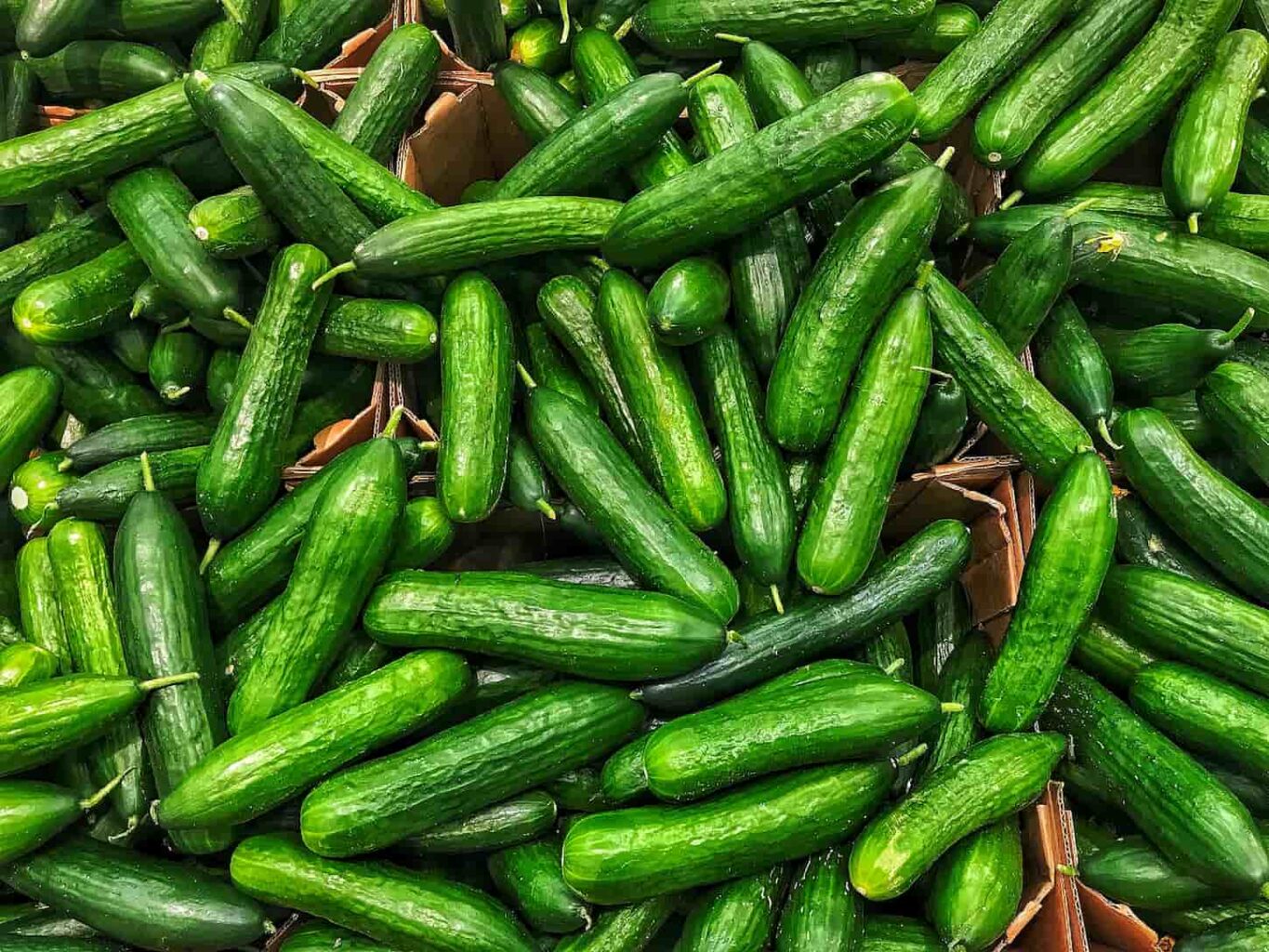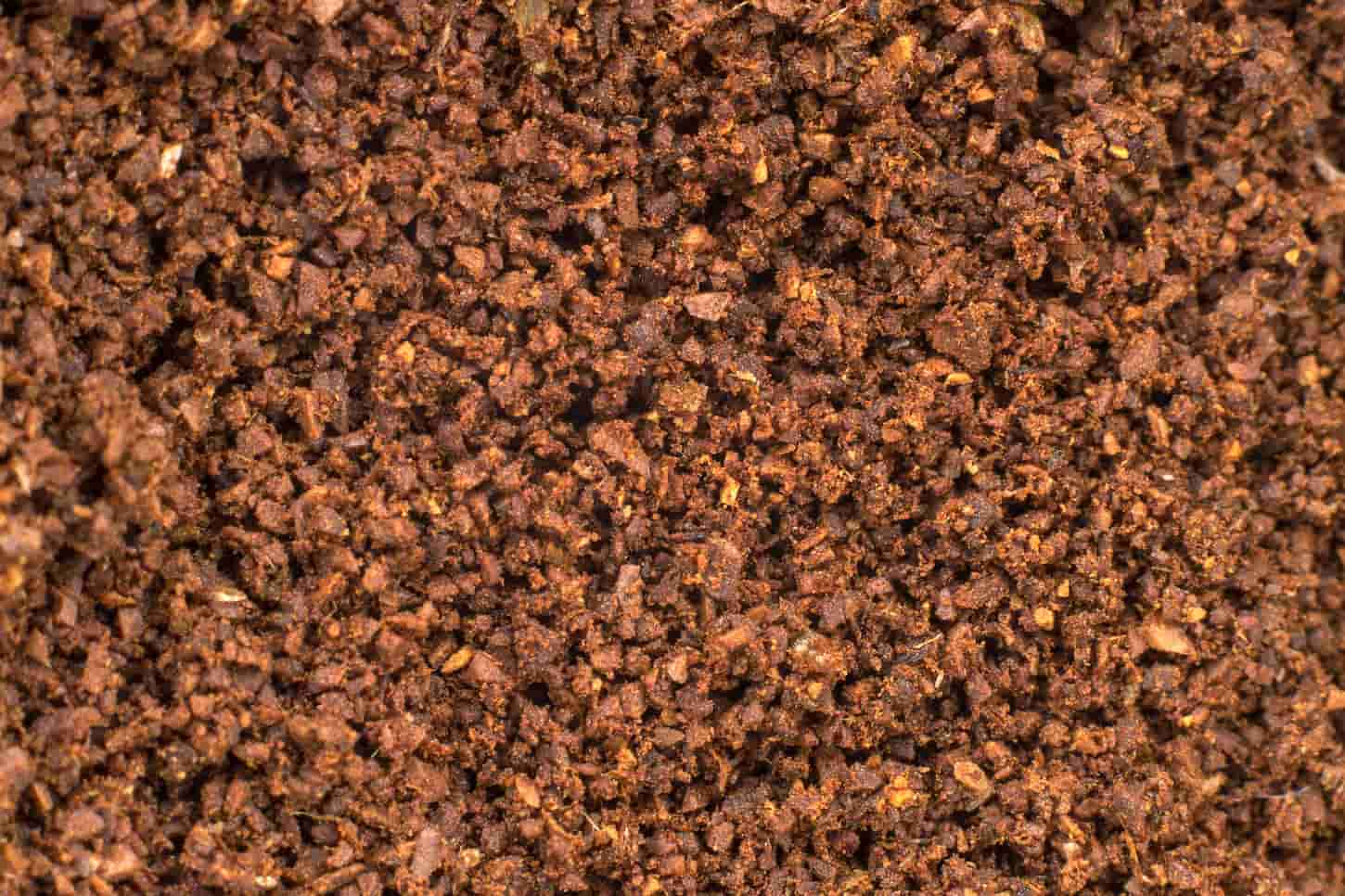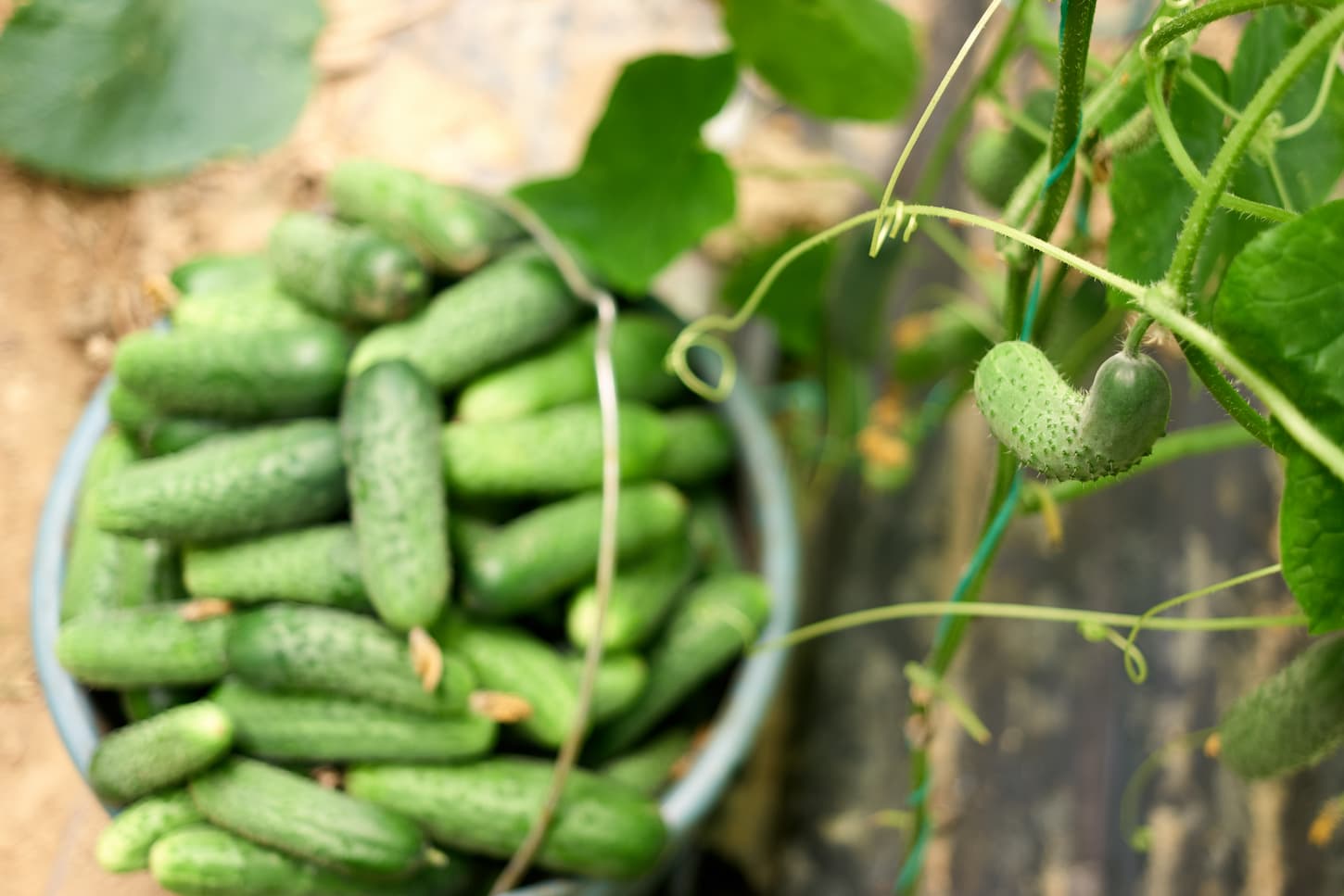If you grow vegetables, it’s normal to seek out environmentally-friendly gardening methods these days. And when it comes to environmentally friendly fertilizer, used coffee grounds are a good choice for most garden plants. So, if you grow cucumbers, you might be wondering if you can give them coffee grounds too?
Cucumbers will thrive when planted in soil fertilized with aged compost that contains coffee grounds if the overall soil nitrogen content is within normalized levels. Cucumbers do best in rich, fertile, and well-draining earth. Coffee grounds fertilize and improve the quality and drainage of the soil.
The great thing about coffee grounds is that they’re completely natural and break down easily in the earth. So, if you want to know more about the benefits of adding coffee grounds to your cucumbers, look at our comprehensive guide below.

What Are Cucumbers? A Quick Recap
Cucumis sativus is the Latin name for cucumbers, and they’re part of the gourd family of plants. Cucumbers taste fresh and delicious in salads and when they’re pickled. And the great news is that they’re one of the easiest fruits to grow in your garden.
Yes, that’s right, even though we refer to cucumbers as a vegetable, botanically speaking, they’re fruit. They’re also annual plants, which means that they die at the end of each growing season. And Cucumis Sativus is a tropical species. So, they have shallow roots, and they love the sun, humidity, and water.
Cucumbers grow on stems from a vine or a bush. Bush species are great for gardens and containers. And vine species grow on a trellis or frame. Vines generally produce more fruit that’s clean and easy to pick. And they’re a great option if you’re limited on space.
There are two main types of cucumbers, ones for slicing and ones for pickling.
- Slicing cucumbers are long, between 6-8 inches (15-20cm).
- Short, pickling cucumbers are around 3 to 4 inches (8 to 10 cm).
Cucumbers grow quickly. In the right conditions, they’re ready to pick in 50 to 70 days.
On top of this, cucumbers are nutritious. They’re high in vitamins K and C, and they’re a great source of fiber and antioxidants.
What is the Best Fertilizer for Cucumbers?
Cucumbers prefer rich, well-fertilized soil that’s low in nitrogen. And the best fertilizer for cucumbers is aged manure compost or a granular fertilizer that’s low in nitrogen and high in phosphorus and potassium. Be careful not to over-fertilize your cucumbers because this can stunt their growth.
The best way to feed your cucumbers is by adding manure to your earth. Aged compost is perfect because it releases its nutrients slowly.
Even though coffee is high in nitrogen, it too releases it slowly, so it’s not bad for your cucumbers. And for the best results, you should mix your coffee grounds with the manure.
To keep your soil fertile for your cucumbers, apply aged manure to your growing patch each year. You can leave it as a layer of mulch over the winter. Or you can work it into your earth with a spade or fork a few weeks before you plant your cucumbers.
Why are Coffee Grounds Good for Plants?
Using coffee grounds in your garden is a cheap and eco-friendly way to fertilize your earth. Used coffee grounds will also improve the texture of the soil, increase the organic matter content, and help to keep it loose and aerated.
Coffee grinds contain lots of nitrogen which is an essential food for plants. As the grinds break down, they slowly release nitrogen into the earth. They also contain smaller amounts of other vital nutrients such as potassium and phosphorus. Coffee grinds also contain trace minerals, such as magnesium, calcium, and iron, which are all good for your plants.
If you live in an area with clay soil, adding coffee grinds is a great way to loosen it up a bit. And some gardeners swear coffee grounds repel pests such as snails and cats.
Coffee grounds may also help defend against harmful soil pathogens. This is because they support beneficial bacteria and increase microbial activity in the soil. So overall, coffee grinds may help to suppress weeds and diseases.
If you don’t drink coffee, you can usually collect large amounts for free from your local coffee shop or from a friend who loves coffee and doesn’t know what to do with all the grounds.
Just be aware that not all coffee shops will give you those grounds for free. Many shops have realized how valuable those “leftover” grounds are to gardeners, and they charge a premium.
Be aware, too, that not all coffee is the same. And not every garden has the same soil, nor can it benefit from coffee grounds. Some gardeners have good results with coffee while others don’t.
So, it can be a case of trial and error when it comes to using coffee grounds in your garden.
Does Coffee Make Soil Acidic?
Fresh coffee grounds will indeed lower the pH of the soil, making it more acidic. This is because coffee is acidic, too. However, used grounds are less acidic than coffee. They are only mildly acidic, so they won’t dramatically change the pH of your soil.
If you’re worried that coffee grounds are making your soil acidic, you can check it regularly with a probe or pH testing kit.
However, the acidity in coffee is neutralized by water, so it shouldn’t alter the pH of your soil too much. Fresh, unbrewed coffee grounds on the other hand are more acidic than brewed grounds and they can alter the pH much more easily. So don’t use fresh grounds to fertilize your soil. Go ahead and brew them first.
Pro tip: Some plants, such as blueberries, thrive on acidic earth. So, you can give these fresh coffee grounds. But you should avoid using them on plants such as lavender that prefer alkaline soil.
Pro-tip #2: If you want to have a bit of fun in your garden, experiment with coffee grounds on your hydrangeas.
In acidic soil, hydrangeas have blue flowers. And in more alkaline soil, their flowers are pink. So, if your hydrangeas have pink flowers put some fresh coffee grounds around them to make future flowers on the same plant blue.

What Plants Can I Put Coffee Grounds On?
Most plants will enjoy it if you add coffee grinds to their soil as part of the compost mix. Acid-loving plants, such as roses, love coffee grinds. However, plants that like strictly alkaline soil won’t do well if you give them coffee grounds.
To give you a clearer idea about this, below, we’ve listed the plants that like coffee grounds and the ones that don’t.
Garden plants that will love compost with Fresh Coffee Grounds
If you have some coffee that’s going out of date, instead of throwing it away, put it on acidic-loving plants such as these.
- Blueberries
- Cranberries
- Raspberries
- Azaleas
- Rhododendron
- Roses
- Hydrangeas
- Holly
- Camellias
- Radishes
- Parsley
- Potatoes
Plants that will love compost with Used Coffee Grounds
Used coffee grounds won’t dramatically alter your pH levels. However, they may make the soil slightly more acidic over time. So, these are the pants that love used coffee grounds.
- Carrots
- Broccoli
- Peppers
- Spinach
- Beans
- Marigolds
- Dill
- Endives
- Spinach
- Tomatoes
- Parsnip
- Rutabagas
- Turnips
- Peppers
- Cauliflower
- Squash
Cucumbers will also fall into this group – if the used coffee grounds are mixed into aged compost before application. This is because cucumbers are sensitive to nitrogen, something that coffee grounds are rich in.
And cucumbers prefer a low-to-normal amount of nitrogen with a higher level of phosphorus and potassium to do well.
Plants that Don’t like Coffee Grounds at all
You should avoid using coffee grounds on plants that prefer alkaline soil. If you use coffee grounds on these types of plants, it could affect their growth and development. So don’t give any of the following plants coffee grounds.
- Asparagus
- Geraniums
- Japanese mustard
- Mustard greens
- Lavender
- Rosemary
- Yuccas
- Succulents and cacti
- Spider Plants
- Orchids
- Pothos Plants
Instead, stick to composts and manures that will help the soil for these plants stay more alkaline.
Want to know more about plants that do well with coffee grounds (or don’t)? Read my articles on these other plants:
- Are Coffee Grounds Good for Tomato Plants?
- Do Onion Plants Like Coffee Grounds? (Read Before Planting!)
How Often Should I Put Coffee Grounds on My Plants?
Most plants will enjoy up to a weekly dose of coffee grinds on their soil. But all plants are different, and for some, such as cucumbers, it’s better if they only have coffee grounds every two or three weeks or as needed, which can be determined by the soil makeup.
So, when you start to give your plants coffee grounds, you must introduce them slowly to give your plants time to adjust. Begin by giving your plants a small number of grounds, just a teaspoon or two, every two weeks.
If your plants seem healthy and fine, you can try giving them grounds every week. But if your plants show any signs of illness, such as yellowing leaves, reduce the number of grounds you give them.
You can give your baby plants coffee grounds when you plant them into a pot or the earth for a bit of extra nutritional support. And you can add coffee grounds to mulch too.
Pro tip: If you mix coffee grounds with crushed eggshells (which contain calcium and phosphorus) then that mixture makes a perfectly balanced N-P-K fertilizer.
However, you shouldn’t put coffee grounds on any kind of seedlings because this will stunt their growth. And always be cautious when you scatter coffee grounds in your garden if you have pets. Coffee grounds can be problematic or even poisonous for some animals, including pets like cats and dogs.

How Do I Give My Plants Coffee Grounds?
Coffee grounds can be applied directly to the earth or container, or mixed into compost and mulch. A coffee brew can also be made to give to some plants as a liquid fertilizer.
It’s easy to give your plants coffee grounds. And below, we’ll tell you exactly how to do it, using all three methods we just mentioned.
Method #1: Coffee in Your Compost
Coffee is a fantastic ingredient for your compost or vermicomposting bin. And when it comes to adding it to your compost, even though coffee is brown, it’s a wet, green ingredient. Brown ingredients are dry things such as dry leaves, newspaper, or sawdust.
Pro tip: for the perfect compost, you should have a 4:1 ratio of brown to green organic matter.
If you have vermicompost, the great news is that your worms will love it if you give them used coffee grounds. Worms seem to enjoy the taste of it, and they benefit from having gritty food, such as coffee in their diet. Give your worms a cup of coffee grounds each week, and you can even give them paper coffee filters too.
Method #2: Coffee in the Earth
The easiest way to give your plants coffee is by scattering it on the top of their earth. This way the nutrients will seep into the soil over time and with watering.
However, make sure that you don’t leave a layer more than half an inch thick on top of your plants. Because this will stick together and make a waterproof crust. To stop a crust from forming, gently rake the ground into the soil.
You can also mix coffee grounds with topsoil or compost to make a potting mix. Or add coffee grounds to mulch as a slow-release fertilizer. Cucumbers, in particular, thrive when they’re covered with a 2-inch layer of mulch during the growing season.
Method #3: Coffee Liquid Fertilizer (Fertilizer Tea)
To make a coffee liquid fertilizer, simply put 2 cups of used grounds in 5 gallons of water. Let this steep overnight, or at least for a few hours, and then use it as a liquid fertilizer for potted and garden plants.
As well as this, some gardeners spray their plants with this special coffee brew. Your plants can absorb nutrients through their leaves. And potentially, it can keep some pests (who don’t like caffeine or the taste of coffee) away from your plants.
Cucumber Grow Tips
Besides using coffee grounds, there are plenty of other things you can do to make sure that you get a good crop of cucumbers each year. And for the best results, follow these tips below.
- Plant cucumbers after any frost danger are past. Don’t plant your cucumbers until at least two weeks after the last frost. Cucumbers are tropical, which means that they’re sensitive to frost. Cold weather will kill or severely damage your cucumbers.
- Cucumbers need consistent sunlight and watering. Give them a deep watering at least once a week. And make sure that they have at least 6 hours of sunshine each day.
- Leave a time gap between cucumber plants to set up easier harvests. When you sow your cucumbers, space out when you plant them. In fact, leave a gap of about two weeks between plantings. This way you’ll have a regular, ongoing supply of your salads (or pickles) throughout the summer. Having those two weeks between harvests will make pickling easier, too.
- Leave a physical gap between cucumbers. Cucumbers need lots of space so you should plant them two to three feet apart.
- Water your cucumbers slowly in the morning or evening. And avoid getting water on their leaves. This will help them grow better and be healthier.
- Attract bees to increase pollination. You can spray your cucumbers with sugar to attract bees for pollination. Or just keep bees.
- Harvest cucumbers the right way. When you harvest your cucumbers, cut from the stem above the fruit. And try not to damage the main vine. You must keep picking the fruit because if you don’t, then your plants will stop producing
- Cucumbers are ready to harvest when they’re medium to dark green and firm. Don’t leave them longer than this because the seeds get hard as they get older, and then they taste bitter.
Cucumbers are a delicious crop, so make sure you enjoy them. And if you haven’t ever pickled your own cucumbers, make sure you add that to your to-try list sometime soon. Pickles are delicious – at least in my opinion, anyway!
Best Products to Manage Growing Cucumbers (with or without coffee grounds)
Personally, I believe that the best option for buying is to buy locally. That way, you aren’t just getting good prices, but also supporting your local economy. That being said, sometimes shopping online is the best (or only) option – like during a lockdown. Hopefully, we don’t have another one.
But just in case, here are some online buying options for getting your cucumber harvest going.
- Soil test and pH meter (click here to see the best pricing on Amazon)
- Starter, 4-tray vermicomposter kit – worms aren’t included, but you can see the sale price on Amazon here.
- 216 gallon, expandable compost bin (click here to see on Amazon)
- Cucumber trellis (can be used for other plants, too) – click here to shop on Amazon
- Don’t have a local seed supplier? Amazon sells cucumber seeds here.
Be sure to check your local nursery’s supplies, though. Odds are you’ve got several around you, so take a day trip and go check all of them out. That way, you can find your favorite one – and see where you may pick your 2nd favorite choice.

Conclusion
Growing cucumbers is easy and rewarding, even more so when your plants produce a large crop that’s been spaced out to make the harvest more manageable.
And one way you can help your cucumbers along is by giving them some coffee grounds every two or three weeks. Not only will this provide vital nourishment, but it will also improve the overall quality of your soil.
Our soil is heavy with clay, so we could totally benefit from adding some coffee grounds to it. This would massively improve our soil quality and our harvests. However, we don’t drink coffee. And all the coffee shops near us charge a premium to get used grounds.
So for now, we stick to using chicken manure and compost to improve our soil quality, as chicken manure is also a nitrogen-rich source. In any case, find what works for your soil, your harvest, and your backyard homestead.
Oh, and no matter your status of coffee grounds or not, make sure you’re composting these cooked veggies. You’d be surprised that you can compost a lot more cooked vegetables than you thought. So make sure you read the article I wrote on composting cooked veggies next.
Resources
Learning from your own experience is essential, but learning from others is also intelligent. These are the sources used in this article and our research to be more informed as homesteaders.
- “Coffee Grounds and Composting.” OSU Extension Service, 4 June 2021, extension.oregonstate.edu/gardening/soil-compost/coffee-grounds-composting.
- Chalker-Scott, Ph.D., Linda. “Coffee Grounds – Will They Perk up Plants?” Washington State University, 2009, s3.wp.wsu.edu/uploads/sites/403/2015/03/coffee-grounds.pdf.
- Oscar, Issac. “List of Plants That Like Coffee Grounds and Which Don’t.” Farming Method, 15 Mar. 2021, farmingmethod.com/list-of-plants-that-like-coffee-grounds.
- Rhoades, Heather. “Composting With Coffee Grounds – Used Coffee Grounds For Gardening.” Gardening Know How, www.gardeningknowhow.com/composting/ingredients/coffee-grounds-gardening.htm.
- Sweetser, Robin. “Cucumbers Harvest: Best Varieties and Cucumber Uses.” Old Farmer’s Almanac, 29 Jan. 2019, www.almanac.com/cucumbers-varieties-and-uses.
- The Old Farmer’s Almanac. “Cucumbers.” Old Farmer’s Almanac, 10 May 2021, www.almanac.com/plant/cucumbers.
